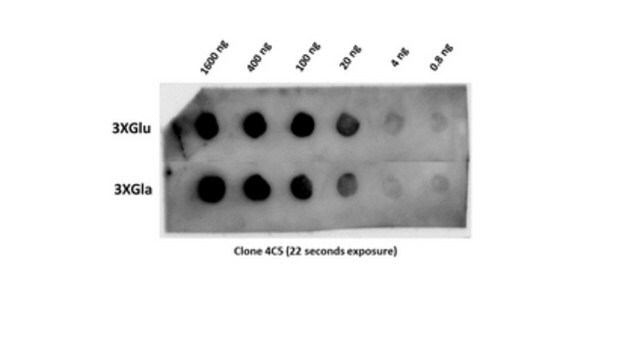您的位置:首页 > 产品中心 > Anti-Osteocalcin Antibody, clone 4C5
Anti-Osteocalcin Antibody, clone 4C5

产品别名
Anti-Osteocalcin Antibody, clone 4C5
Bone Gla protein, BGP, Gamma-carboxyglutamic acid-containing protein
基本信息
| eCl@ss | 32160702 |
| NACRES | NA.41 |
| General description【一般描述】 | Osteocalcin (UniProt: P02818; also known as Bone Gla protein, BGP, Gamma-carboxyglutamic acid-containing protein) is encoded by the BGLAP gene (Gene ID: 632) in human. Osteocalcin is a member of the osteocalcin/matrix Gla protein family and can constitute 1 to 2% of the total bone protein. It is synthesized by osteoblasts and is a major component of the noncollagenous bone matrix. Osteocalcin is synthesized with a signal peptide (aa 1-23), a propetide (aa 24-51) that are cleaved to generate active secreted form of osteocalcin (aa 52-100). Osteocalcin displays a high affinity for calcium and binds strongly to apatite. Sixty to ninety percent of de novo synthesized osteocalcin is incorporated into the bone matrix where it binds to hydroxyapatite during matrix mineralization. The remainder of the osteocalcin is released into the circulation where it can be measured as a sensitive marker of bone formation. Osteocalcin found in serum is almost exclusively derived from the bone formation with little or no contribution from the resorption process. A major feature of osteocalcin is the presence of 3 vitamin K-dependent gamma-carboxyglutamic acid (Gla) residues, which are found in the first helical region and interact with the inter-calcium spacing in the HAP lattice. In humans, the percentage of the circulating osteocalcin that is not gamma-carboxylated is used as a biomarker of vitamin K status. Osteocalcin expression in osteoblasts is stimulated by insulin and adiponectin and osteocalcin enhances insulin sensitivity and differentiation in muscle. Serum osteocalcin is elevated in diseases characterized by increased bone turnover such as osteoporosis, hyperparathyroidism and Paget′s disease, and low in conditions associated with low bone turnover such as hypoparathyroidism and growth hormone deficiency. (Ref.: Kanazawa I (2015). World J Diabetes. 6(18): 1345 1354; Gundberg, CM et al. (2012). Adv Nutr 3 (2): 149-157). |
| Specificity【特异性】 | Clone 4C5 detects all forms of human osteocalcin. |
| Application【应用】 | Dot Blot Analysis: A representative lot detected 3xGlu, Glu17, and 3XGla peptides for human OCN (Courtesy of Mathieu Ferron, Ph.D., Montreal Clinical Research Institute, Montreal, Canada). Anti-Osteocalcin, clone 4C5, Cat. No. MABS1989, is a moue monocloanl antibody that detects osteocalcin and has been tested for use in Dot Blot. |
| Quality【质量】 | Dot Blot Analysis: A 1:250 dilution from a representative lot detected Osteocalcin at a wide range of concentrations (0.8 to 1600 ng). |
| Physical form【外形】 | Protein G purified Format: Purified |
| Other Notes【其他说明】 | Concentration: Please refer to lot specific datasheet. |
产品性质
| Quality Level【质量水平】 | 100 |
| biological source【生物来源】 | mouse |
| antibody form【抗体形式】 | serum |
| antibody product type | primary antibodies |
| clone【克隆】 | 4C5, monoclonal |
| species reactivity | human |
| packaging【包装】 | antibody small pack of 25 μL |
| technique(s) | dot blot: suitable |
| isotype【同位素/亚型】 | IgG1κ |
| NCBI accession no.【NCBI登记号】 | NP_954642.1 |
| UniProt accession no.【UniProt登记号】 | P02818 |
| shipped in【运输】 | ambient |
产品说明
| Target description【目标描述】 | 10.96 kDa calculated. |
| 【免责声明】 | Unless otherwise stated in our catalog or other company documentation accompanying the product(s), our products are intended for research use only and are not to be used for any other purpose, which includes but is not limited to, unauthorized commercial uses, in vitro diagnostic uses, ex vivo or in vivo therapeutic uses or any type of consumption or application to humans or animals. |




